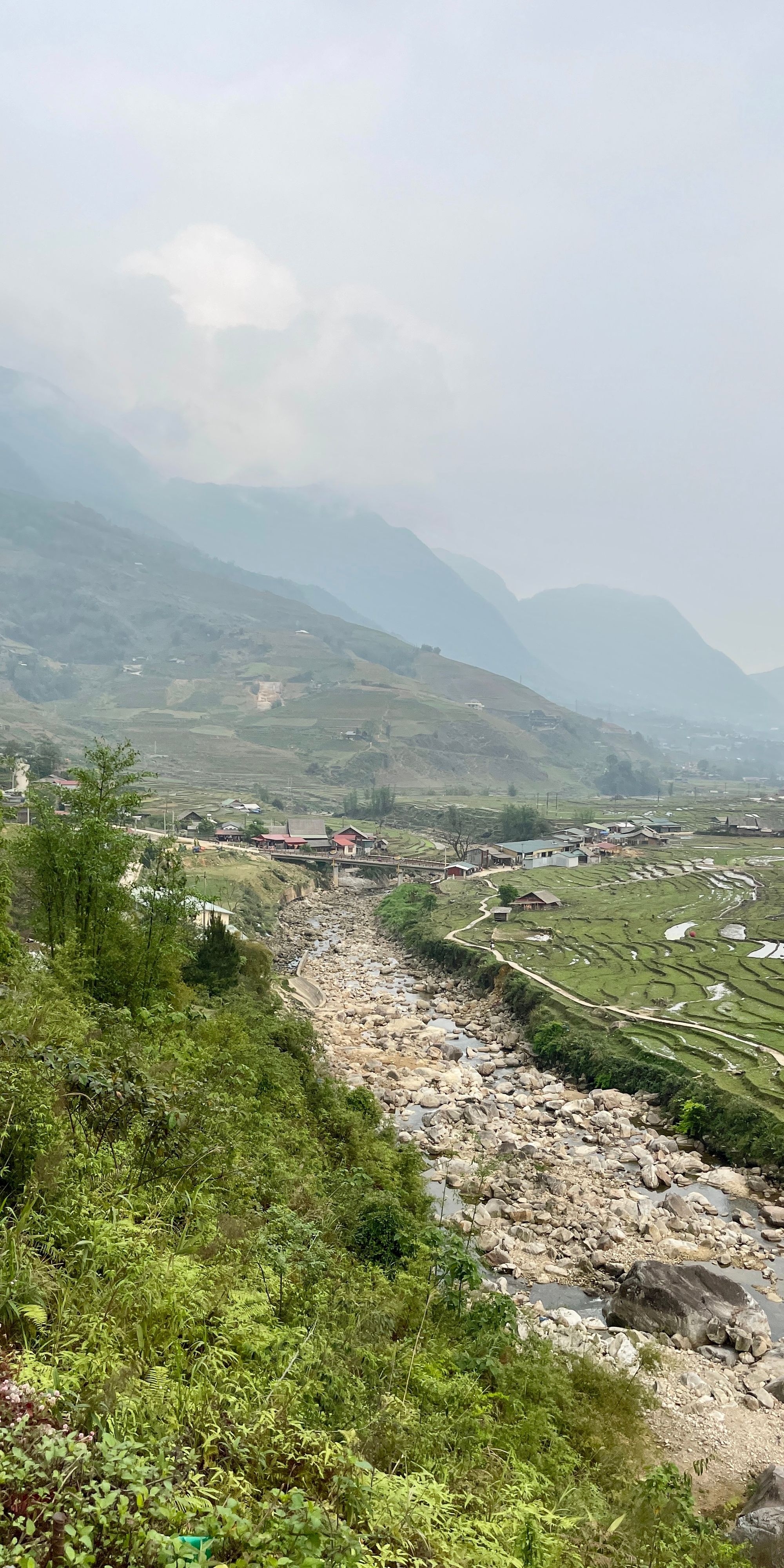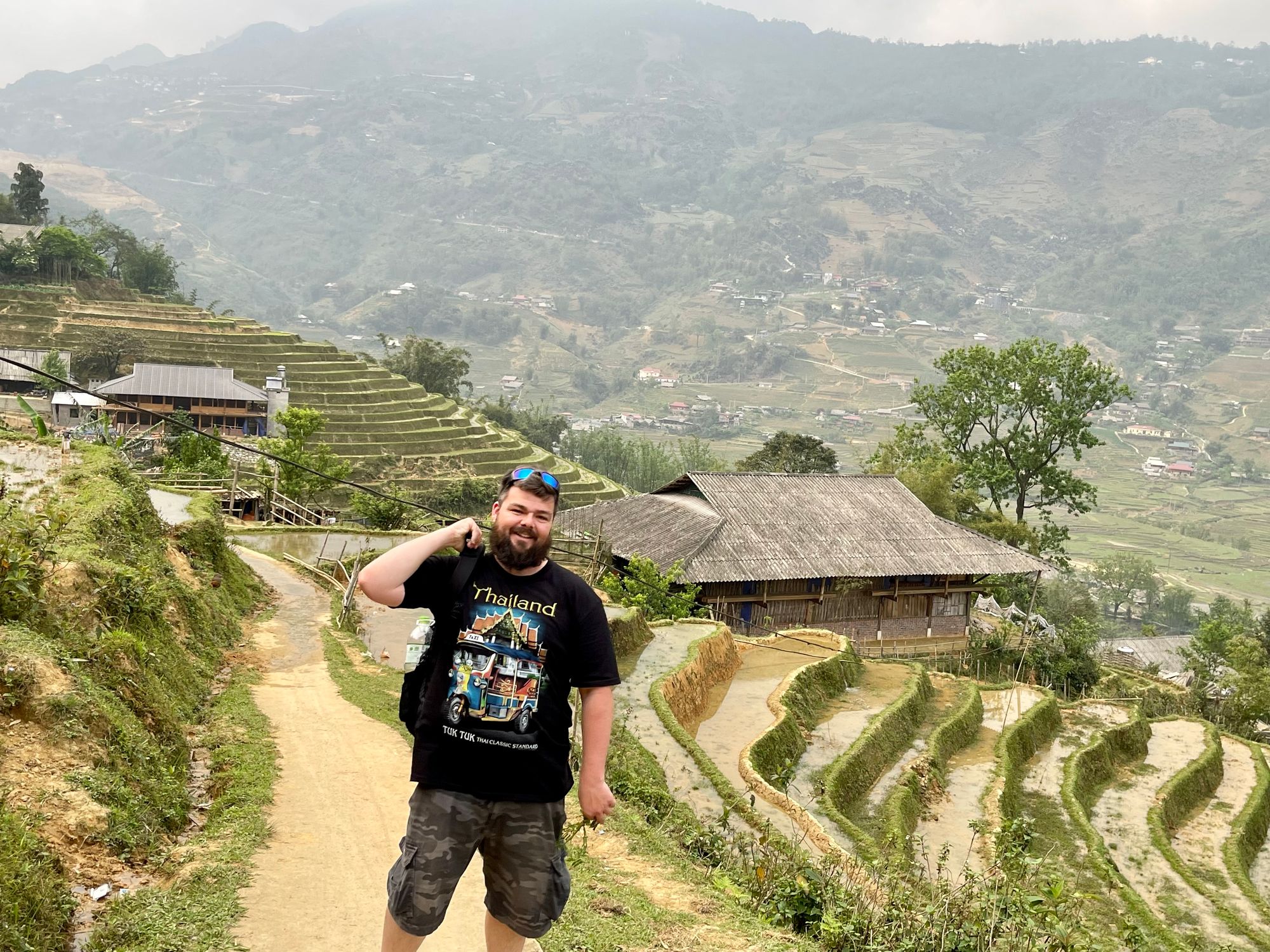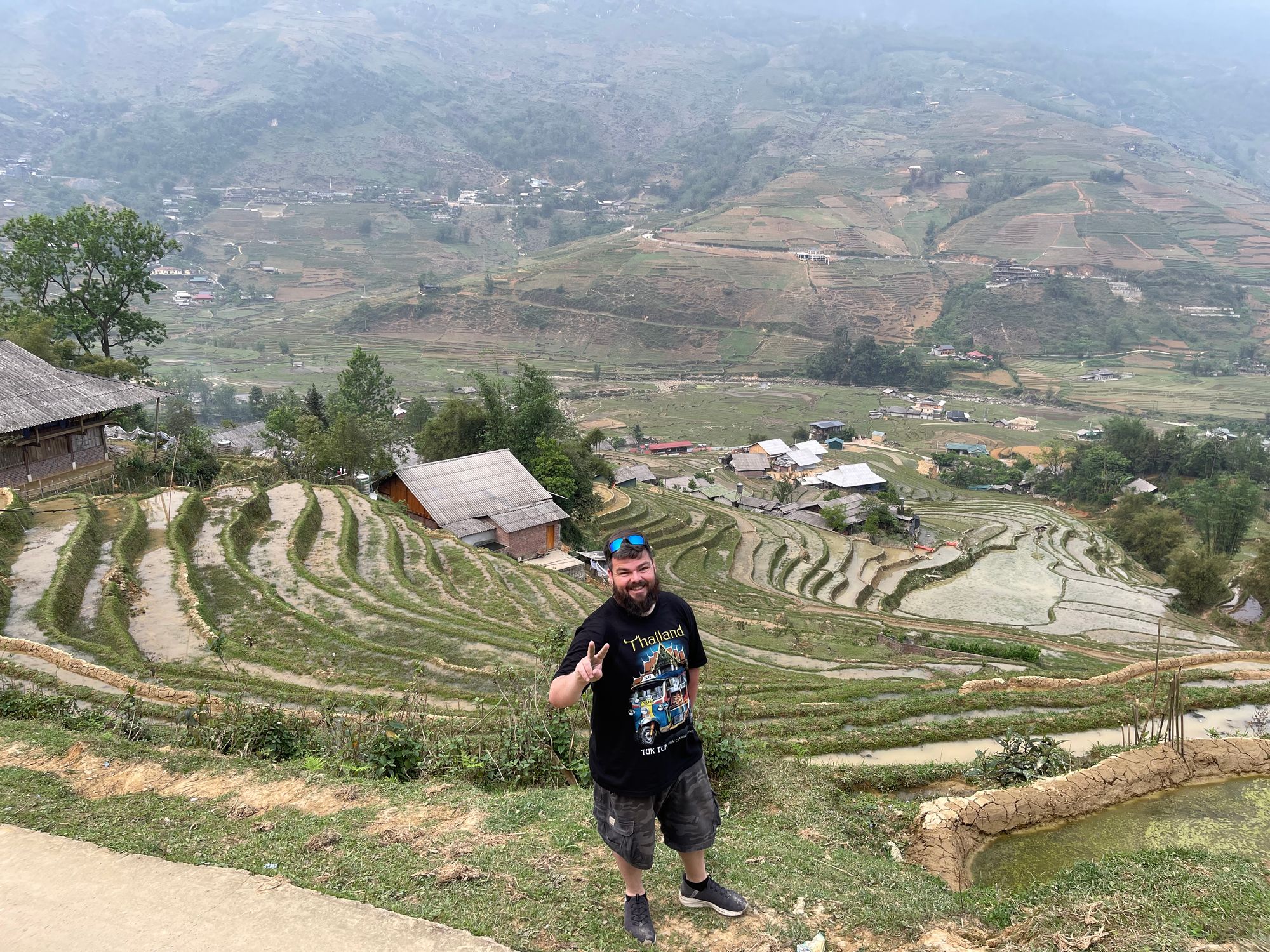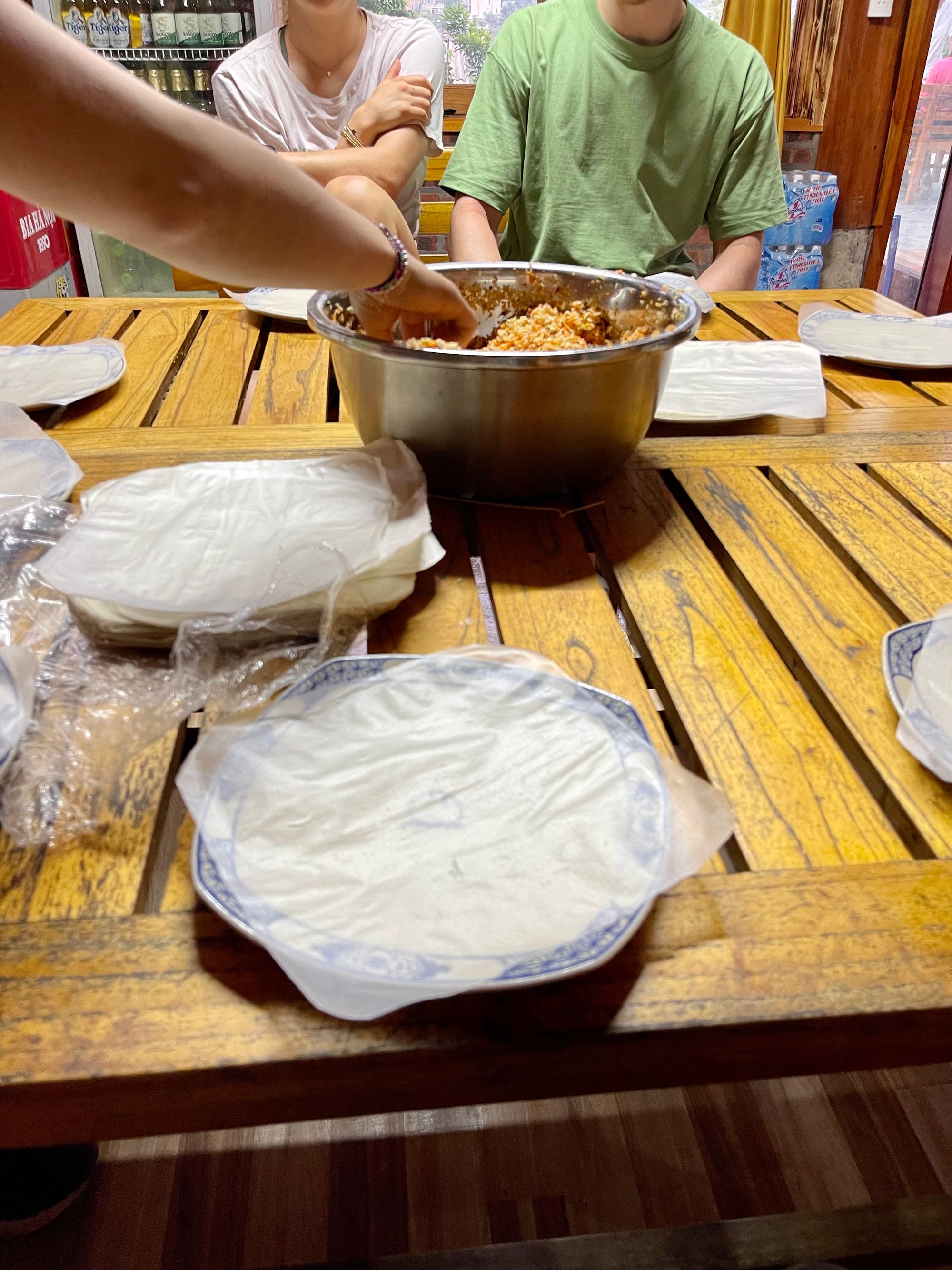Overnight in Ta Van Village

So far, I would have to say this is by far the best experience I have had while traveling in Vietnam. Between the people I had met and my adventures on tour, this would be on my must-do list if you asked me for things to do in Vietnam. My day started where the Traveling to Sapa article ended. After stepping off of the bus and getting through the crowd of saleswomen all asking if I need a taxi or want to shop for jewelry or handmade bags from their backpack, I see a young-looking guy holding a piece of paper with five names on it, one of them being mine. I approach him and hit him with the “Hey, I'm Andrew Brown.” He smiles and replies, “Yes, oh yes!” he looks at the list and says, “Which one?” I knew I was in the correct place when the conversation fell apart at pointing to my name on a piece of paper. After finally sorting out which name on the list was mine, he asked me to wait while he left to find the rest of the guests on our tour after locating the group. Once the group was situated, finally consisting of a Russian couple and an Italian couple, and myself, we were led to a local restaurant.

After getting to the restaurant I learned that it is a blessing to have grown up speaking English as a first language. I watched as the Russian couple began asking for their itinerary, and the locals started trying to explain what they would be doing. The problem arose when the Russians couldn’t understand what the locals were saying, not due to a dialect but since neither knew synonyms for the words they were using. One example is that the tour consisted of going trekking. The Russians didn’t know this word, and the locals didn’t know another word to use in its place. I explained that it was hiking, and now I am the unofficial Russian-Vietnamese translator. When I don't know anything of the two languages but enough English, I could throw out synonyms until something stuck or could describe the activity enough that they understood each other.


After our lunch and we figured out what the Russians' itinerary was, it was time to go separate ways. The Italians and Russians chose to stay in a hotel and visit the village during the day, where I decided to sleep in the village for the night. After they left in the golf cart headed to the hotel, and we said our farewells. I ordered a tea from the shop and waited until my tour guide arrived. After a few minutes of sipping my Vietnamese tea was when I met Zu, my tour guide.

Zu is 28 years old with multiple kids and has never left Sa Pa. She picked me up on one of the village motorbikes and told me how it was my lucky day because she told me usually, when there is more than one person, she has to walk to town and then back with the travelers, and that walk usually takes about 4 hours. Since it was only me, we could take the motorbike to the village and use the time saved to stop and take pictures along the way. The first leg of our trip was a short ride through Sa Pa. We did not make any stops, but I got a few pictures on the back of the motorbike.




Once we were out of the city, the landscape opened up immediately into the mountains and valley images shared on videos about Vietnam terraces down the mountainsides and scattered homes throughout the hills. The roads had many Vietnamese women walking to and from the village with their handmade items to sell to tourists visiting Sa Pa and the nearby Villages. The roads had many Vietnamese women and kids walking to and from the village with their handmade items to sell to tourists visiting Sa Pa and the nearby Villages. There would also be children guiding buffalo along the streets to make sure that the buffalo did not wander into the rice fields and eat neighboring rice plants. As we rode the motorbike towards the village, we would pass groups of foreigners along the road, all hiking down towards the village.







Once we turned off the paved street onto the dirt roads, the roads became quite extreme. Lots of bumps and steep grades at times; it was so steep I would have to get off of the motorbike to allow Zu to drive the motorbike down while I walked down. Walking portions of the route gave me great photos as we descended into the valley. We started passing through other villages on the way to Va Tan village. There were shops with kids playing and children caring for their younger siblings by carrying them around. It was a huge difference to see these kids taking care of their younger siblings like that. In America, you would go to prison if the government found out you let your kids care for your other kids.









After the nice motorbike ride, we finally got to the Ta Van Village, where we left the motorbike in a communal parking spot. Then set off to walk through the village where Zu taught me about life in the village. She explained that most of the income for the village comes from tourism to the village, which only started in 2015 after the Vietnam government had completed a cable car track. She explained how the completion of the cable car drove much more tourists to visit Sa Pa as well as began driving the growth of the village. Many villagers began renting out rooms in their homes to the tourists, which made these families rich, and they are now the owners of the most modern homes in the village. She explained that this also led to the village building its first hotel as which is now one of the tallest buildings in the village.








As we walked through the village, we occasionally stopped so that Zu could show me some of the daily activities around the village. One activity was putting rice into a spinning stone gadget that you would manually push and pull, turning the top stone, and grinding the rice into a flower for many of their recipes. Another was where the villagers would use water to make an automatic rice husking machine using counterweights. Another was using indigo plants to grind the leaves and dye their clothes dark blue. There was also an older lady and a child that began following Zu and me through the village and helping to show me things. The older woman’s hands were still dyed blue from dying some clothes blue that she could later sell to visitors to the village.








About one and a half hours into our walk through the village, the old lady and child would tell Zu they were about to leave to head back into the main town. I didn’t know then, but Zu would later tell me that the older woman explained to her in Vietnamese that the 2 of them had difficulty selling any items that day. No one had bought anything, and I was their last ditch attempt before calling it a night. Even though I did not know about the difficulties they had selling that day, I felt that they put the effort in to deserve a purchase from me, these two not only walked for hours with us but they had also taken part in showing how to use the indigo plant to turn my hands blue as well as her and the little girl had taken small pieces of plants to make a heart as well as a horse for me. I bought one handbag from each of them, costing 100,000 dong. (USD 4.26) The two were thankful and even gave me two extra bracelet as a thank-you.

After saying our goodbyes to the older woman and little girl, Zu and I completed our hike by walking up one more hill, where I met the rest of the group with my tour, A couple from the Netherlands, Remy and Kiki, two friends from California, Jim and Omid, three guys from Germany, Fredrick, Jonas, and Alfred.

After quickly getting acquainted, Zu came out of the kitchen with a plate of rice papers and a bowl of filling, where we got to roll our spring rolls for dinner. After rolling the spring rolls, we all sat around the table telling stories about our travels, some from a long time ago and some from just a few days ago. We would tell about our experiences in our home country and how different things Are here in Vietnam. A significant cultural difference that seems to be shared in Western culture, which is non existent in Vietnam, is the social aspect. In Western cultures, most people stay away from others, but in Asian countries, entire communities live together and even invite themselves into each other's homes. With no lack of conversation among our group, the people in the kitchen began filling our table with plates of food and placing a small bowl in front of us so that we can grab what we want to put into our bowl and eat from our bowl before refilling our bowl. With the food, the locals also brought out “happy water,” a bowl of rice wine that you can scoop out of a thimble into your shot glass, which the homeowner walked us through the chant that groups make before taking their shot.









After dinner, the group sat around the table, continuing to tell stories for about another hour before we, one by one headed to our rooms to go to sleep for the night. The following article will be about trekking through Ta Van Village.
Member discussion